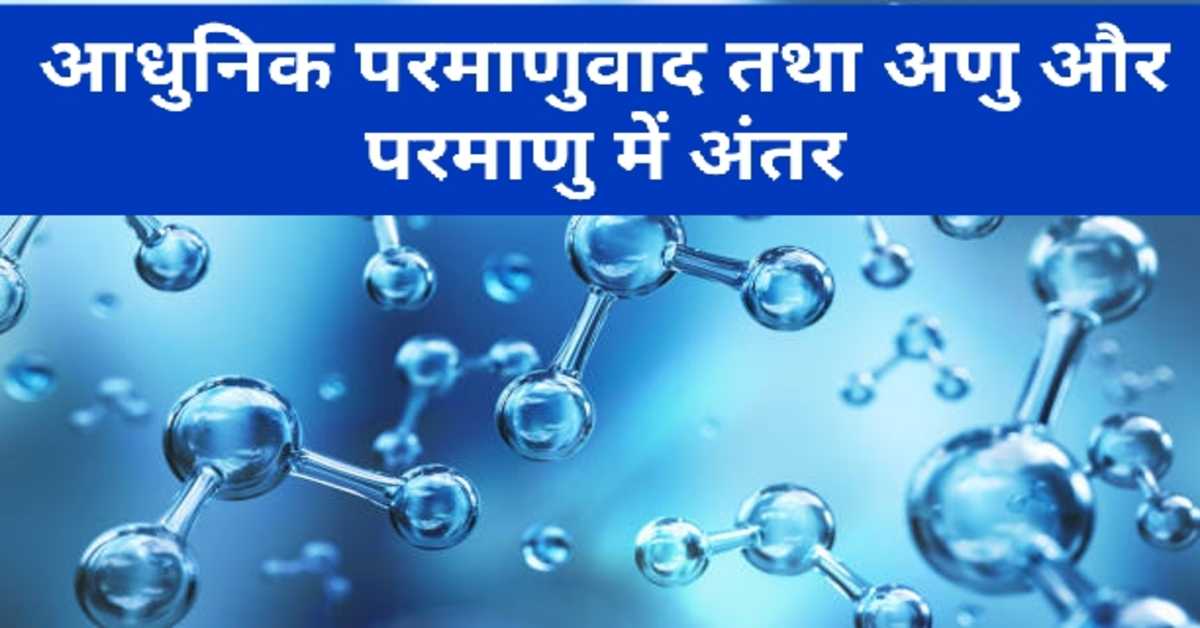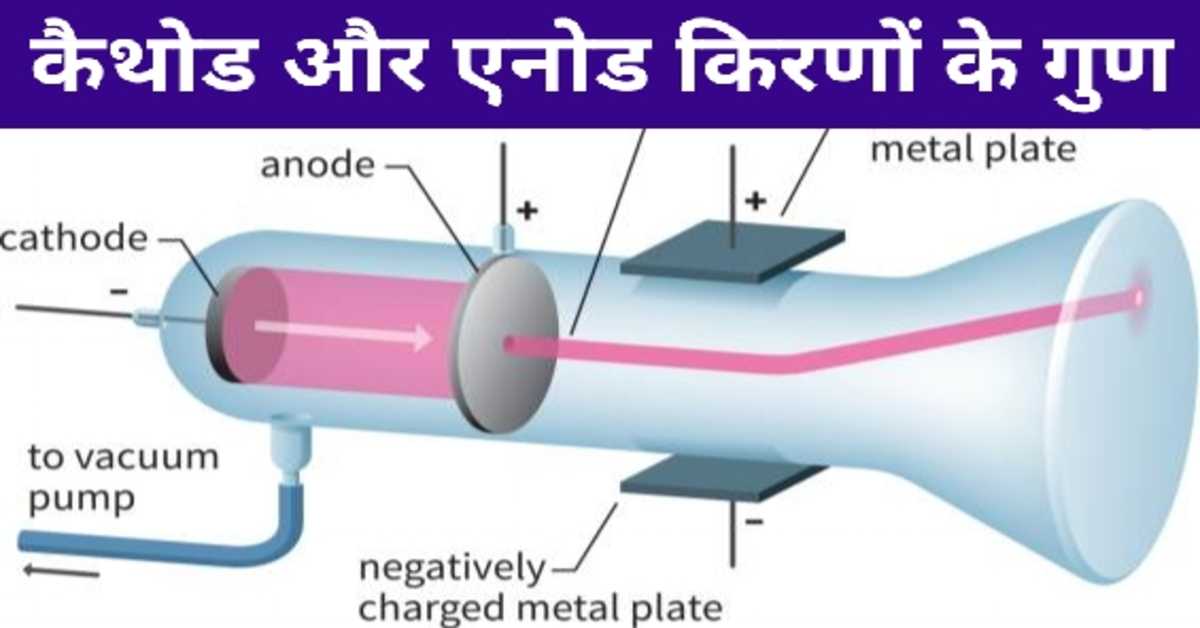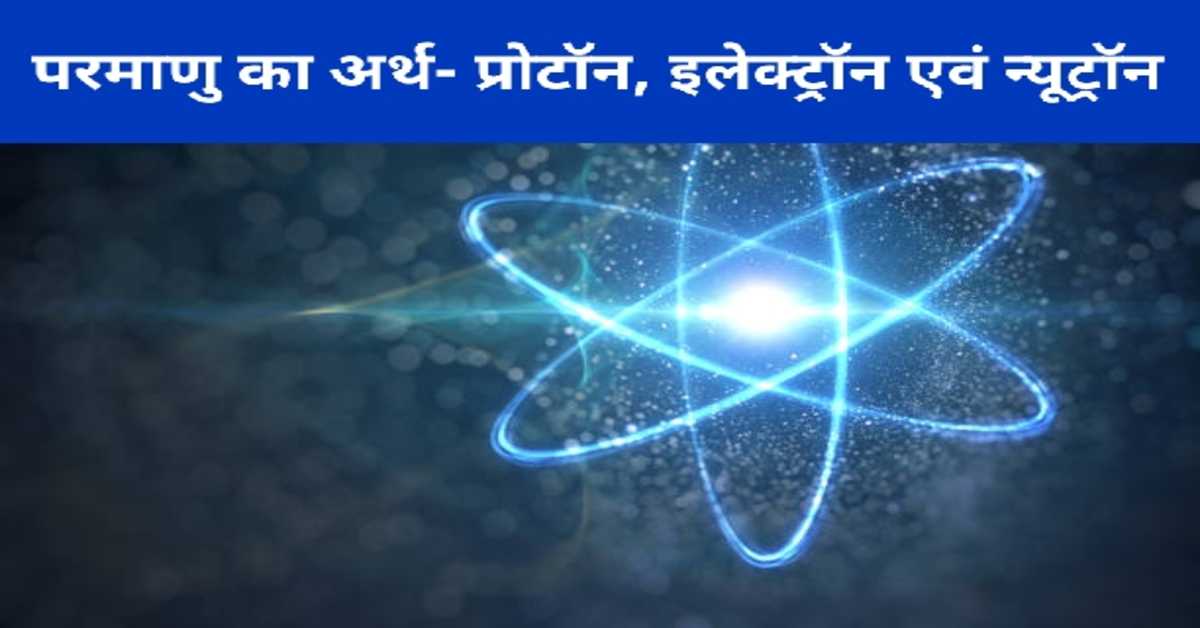
आधुनिक परमाणुवाद तथा अणु और परमाणु में अंतर | Modern Atomism and difference between Molecule and Atom
आधुनिक परमाणुवाद- परमाणुवाद या परमाणु सिद्धांत वर्तमान में डॉल्टन के नाम से जाना जाता है। क्योंकि रासायनिक संयोग के नियमों को इस नियम द्वारा आसानी से व्यक्त किया जा सकता है। किन्तु बहुत से रासायनिक एवं भौतिक शास्त्री जैसे-रदरफोर्ड, थॉमसन, बोर आदि ने शोध के आधार पर इसमें कुछ सुधार किए जिसे आधुनिक परमाणुवाद के नाम से जाना जाता है। इसके मुख्य बिंदु निम्न हैं-
1. परमाणु अविभाज्य नहीं है तथा यह विभिन्न छोटे-छोटे रचक कण जैसे- इलेक्ट्रॉन, प्रोटॉन, न्यूट्रॉन से मिलकर बना होता है।
2. एक ही तत्व के परमाणु भार अलग-अलग हो सकते हैं, जिन्हें 'समस्थानिक' कहते हैं।
3. भिन्न-2 तत्वों के परमाणु भार समान हो सकते हैं, जिन्हें 'समभारिक' कहते हैं।
4. परमाणु रसायनिक अभिक्रिया में भाग लेने वाला सूक्ष्मतम स्वतंत्र कण होता है।
5. विभिन्न परमाणु एक-दूसरे से निश्चित व सरल अनुपात में सहयोग करते हैं। किंतु कई जटिल यौगिकों में यह आवश्यक नहीं कि अवयवी तत्व एक सरल अनुपात में ही संयोग करते हैं।
जैसे- शुक्रोज कार्बन, हाइड्रोजन और ऑक्सीजन में 12ः22ः11 है।
6. 'संयुक्त परमाणु' नामक कोई चीज नहीं है। किंतु परमाणुओं के संयोग से बने यौगिक का सबसे छोटा कण अणु होता है।
रसायन विज्ञान के इन 👇 प्रकरणों को भी पढ़ें।
1. रसायन विज्ञान की प्रमुख शाखाएँ, विभिन्न क्षेत्रों में योगदान और शोध व अध्ययन के संस्थान
2. रसायनज्ञ- डॉ. प्रफुल चंद राय, डॉ. हरगोविंद सिंह खुराना, लेवोजिए
3. डाल्टन का परमाणु वाद एवं इसकी अवधारणाएँ
Modern Atomism- Atomicism or Atomic Theory is currently known as Dulton. Because the laws of chemical combination can be easily expressed by this law. But many chemical and physicist like- Rutherford, Thomson, Bohr etc. made some improvements on the basis of research which is known as modern atomism. Its main points are as follows-
1. Atom is not indivisible and it is made up of various small constituent particles like- electron, proton, neutron.
2. The same element can have different atomic mass, which are called 'isotopes'.
3. Different-2 elements can have the same atomic mass, which are called 'isotopes'.
4. Atom is the smallest free particle participating in a chemical reaction.
5. Different atoms cooperate with each other in definite and simple proportions. But in many complex compounds it is not necessary that the constituent elements combine only in a simple ratio.
eg- sucrose Carbon, hydrogen and oxygen have 12:22:11.
6. There is no such thing called 'combined atom'. But the smallest particle of a compound formed by combining atoms is a molecule.
भौतिकी विज्ञान के इन 👇 प्रकरणों को भी पढ़ें।
1. भौतिक राशियाँ और उनके मात्रक
2. प्रमुख भौतिक शास्त्री एवं उनका योगदान
3. न्यूटन के गति के नियम
4. भौतिकी के प्रमुख उपकरण एवं उनके आविष्कारक
अणु और परमाणु में अंतर निम्नलिखित है-
1. किसी तत्व का सूक्ष्मतम कण जो स्वतंत्र अवस्था में रहता है, अणु कहलाता है। जबकि किसी तत्व का सूक्ष्मतम कण जो स्वतंत्र अवस्था में नहीं रह सकता, परमाणु कहलाता है।
2. अणु रासायनिक अभिक्रिया में विभाजित होता है। जबकि परमाणु रासायनिक क्रिया में विभाजित नहीं होता है।
3. अणु रासायनिक क्रिया में भाग नहीं लेता है। (बहुलक अपवाद है।) जबकि परमाणु रसायनिक क्रिया में भाग लेता है।
4. अणु एक या अनेक प्रकार के परमाणुओं के संयोग से बनते हैं। जबकि किसी तत्व के सभी परमाणु समान होते हैं।
5. उदाहरण- समपरमाणुक अणु जैसे- O2, N2, P4, S8
विषमपरमाणुक अणु जैसे- HCl, CH4
Difference between atom and atom is-
1. The smallest particle of an element which exists in its free state is called a molecule. Whereas the smallest particle of an element which cannot exist in free state is called atom.
2. Molecule splits in chemical reaction. Whereas atom does not split in chemical reaction.
3. Molecule does not take part in chemical reaction. (polymer is the exception.) Whereas atom takes part in chemical reaction.
4. Molecules are formed by the combination of one or more types of atoms. Whereas all the atoms of an element are same.
5. Example- Isoatomic molecules like- O2, N2, P4, S8
Heteroatomic molecules like- HCl, CH4
इन 👇परीक्षापयोगी प्रकरणों के बारे में भी जानें।
1. जांतव रेशे
2. प्राणियों में पोषण- पाचन तंत्र
3. पादपों में पोषण- प्रकाश संश्लेषण
4. विज्ञान की शाखाएँ-जीवधारियों का नामकरण व वर्गीकरण
5. पारिस्थितिकी तंत्र जैविक एवं अजैविक घटक
6. रक्त का विज्ञान
आशा है, उपरोक्त जानकारी परीक्षार्थियों / विद्यार्थियों के लिए ज्ञानवर्धक एवं परीक्षापयोगी होगी।
धन्यवाद।
RF Temre
infosrf.com
संबंधित जानकारी नीचे देखें।
(Watch related information below) 👇🏻

आशा है, उपरोक्त जानकारी उपयोगी एवं महत्वपूर्ण होगी।
(I hope the above information will be useful and important. )
Thank you.
R. F. Tembhre
(Teacher)
infosrf.com





Comments